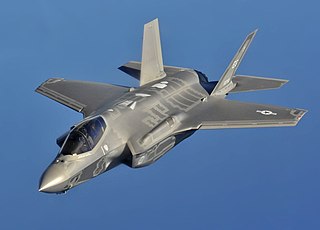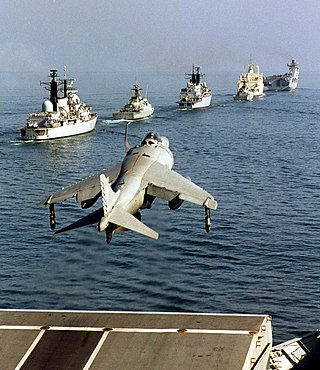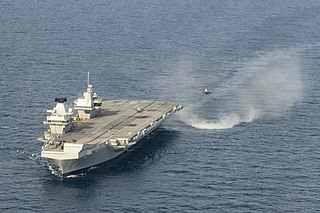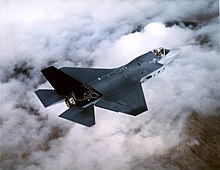
The Lockheed Martin F-35 Lightning II is an American family of single-seat, single-engine, all-weather stealth multirole combat aircraft that is intended to perform both air superiority and strike missions. It is also able to provide electronic warfare and intelligence, surveillance, and reconnaissance capabilities. Lockheed Martin is the prime F-35 contractor, with principal partners Northrop Grumman and BAE Systems. The aircraft has three main variants: the conventional takeoff and landing (CTOL) F-35A, the short take-off and vertical-landing (STOVL) F-35B, and the carrier-based (CV/CATOBAR) F-35C.

A short take-off and vertical landing aircraft is a fixed-wing aircraft that is able to take off from a short runway and land vertically. The formal NATO definition is:
A Short Take-Off and Vertical Landing aircraft is a fixed-wing aircraft capable of clearing a 15 m obstacle within 450 m of commencing take-off run, and capable of landing vertically.
A vertical take-off and landing (VTOL) aircraft is one that can take off and land vertically without relying on a runway. This classification can include a variety of types of aircraft including helicopters as well as thrust-vectoring fixed-wing aircraft and other hybrid aircraft with powered rotors such as cyclogyros/cyclocopters and gyrodynes.

In current military parlance, a strike fighter is a multirole combat aircraft designed to operate both as an attack aircraft and as an air superiority fighter. As a category, it is distinct from fighter-bombers. It is closely related to the concept of interdictor aircraft, but it puts more emphasis on aerial combat capabilities as a multirole combat aircraft. Examples of contemporary American strike fighters are the McDonnell Douglas F-15E Strike Eagle, Boeing F/A-18E/F Super Hornet, and Lockheed Martin F-35 Lightning II.

The Harrier, informally referred to as the Harrier jump jet, is a family of jet-powered attack aircraft capable of vertical/short takeoff and landing operations (V/STOL). Named after a bird of prey, it was originally developed by British manufacturer Hawker Siddeley in the 1960s. The Harrier emerged as the only truly successful V/STOL design of the many attempted during that era. It was conceived to operate from improvised bases, such as car parks or forest clearings, without requiring large and vulnerable air bases. Later, the design was adapted for use from aircraft carriers.

A vertical and/or short take-off and landing (V/STOL) aircraft is an airplane able to take-off or land vertically or on short runways. Vertical takeoff and landing (VTOL) aircraft are a subset of V/STOL craft that do not require runways at all. Generally, a V/STOL aircraft needs to be able to hover. Helicopters are not considered under the V/STOL classification as the classification is only used for aeroplanes, aircraft that achieve lift (force) in forward flight by planing the air, thereby achieving speed and fuel efficiency that is typically greater than the capability of helicopters.

The Lockheed Martin X-35 is a concept demonstrator aircraft (CDA) developed by Lockheed Martin for the Joint Strike Fighter program. The X-35 was declared the winner over the competing Boeing X-32 and a developed, armed version went on to enter production in the early 21st century as the F-35 Lightning II.

The General Electric/Rolls-Royce F136 was an advanced turbofan engine being developed by General Electric and Rolls-Royce plc for the Lockheed Martin F-35 Lightning II. The two companies stopped work on the project in December 2011 after failing to gather Pentagon support for further development.

The Boeing X-32 is a concept demonstrator aircraft that was designed for the Joint Strike Fighter competition. It lost to the Lockheed Martin X-35 demonstrator, which was further developed into the Lockheed Martin F-35 Lightning II.

The Pratt & Whitney F119, company designation PW5000, is an afterburning turbofan engine developed by Pratt & Whitney for the Advanced Tactical Fighter (ATF) program, which resulted in the Lockheed Martin F-22 Raptor. The engine delivers thrust in the 35,000 lbf (156 kN) class and was designed for sustained supersonic flight without afterburners, or supercruise. Delivering almost 22% more thrust with 40% fewer parts than its F100 predecessor, the F119 allows the F-22 to achieve supercruise speeds of up to Mach 1.8. The F119's nozzles incorporate thrust vectoring that enable them to direct the engine thrust ±20° in the pitch axis to give the F-22 enhanced maneuverability.

The Pratt & Whitney F135 is an afterburning turbofan developed for the Lockheed Martin F-35 Lightning II, a single-engine strike fighter. It has two variants; a Conventional Take-Off and Landing (CTOL) variant used in the F-35A and F-35C, and a two-cycle Short Take-Off Vertical Landing (STOVL) variant used in the F-35B that includes a forward lift fan. The first production engines were delivered in 2009.

The Boeing F/A-18E and F/A-18F Super Hornet are a series of American supersonic twin-engine, carrier-capable, multirole fighter aircraft derived from the McDonnell Douglas F/A-18 Hornet, in service with the armed forces of the U.S., Australia, and Kuwait. The F/A-18E single-seat and F/A-18F tandem-seat variants are larger and more advanced versions of the F/A-18C and D Hornet, respectively.

The Joint Combat Aircraft (JCA) is the official designation of the United Kingdom Ministry of Defence used for the F-35 Lightning II. The F-35, developed from the X-35, is the result of the Joint Strike Fighter program.

The Rolls-Royce LiftSystem, together with the F135 engine, is an aircraft propulsion system designed for use in the STOVL variant of the F-35 Lightning II. The complete system, known as the Integrated Lift Fan Propulsion System (ILFPS), was awarded the Collier Trophy in 2001.
Paul Michael Bevilaqua is an aeronautics engineer at Lockheed Martin in California. In 1990, he invented the lift fan for the Joint Strike Fighter F-35B along with fellow Skunk Works engineer, Paul Shumpert.

Lockheed Martin F-35 Lightning II procurement is the planned selection and purchase of the Lockheed Martin F-35 Lightning II, also known as the Joint Strike Fighter (JSF) by various countries.
The British Aerospace P.125 was a British supersonic STOVL multirole combat aircraft being developed in the 1980s. The project was cancelled in the 1990s. The existence of the project was revealed by BAE Systems in 2006.

Shipborne rolling vertical landing (SRVL) is a method used to land a V/STOL aircraft that uses both the vertical thrust from the jet engine and lift from the wings.

Lockheed Martin F-35 Lightning II development started in 1995 with the origins of the Joint Strike Fighter program and culminated in the completion of operational testing and start of full-rate production in 2021. The X-35 first flew on 24 October 2000 and the F-35A on 15 December 2006.

Arthur Tomassetti is a retired United States Marine Corps colonel, combat veteran, and test pilot who is notable for his work on the Joint Strike Fighter (JSF) and F‑35 Lightning II. During twenty-one years on the programs, he worked in key roles developing pilot interfaces, testing aircraft capabilities, fielding aircraft to operational units, and establishing the F-35 training organization that certifies US and international pilots and maintainers.


















